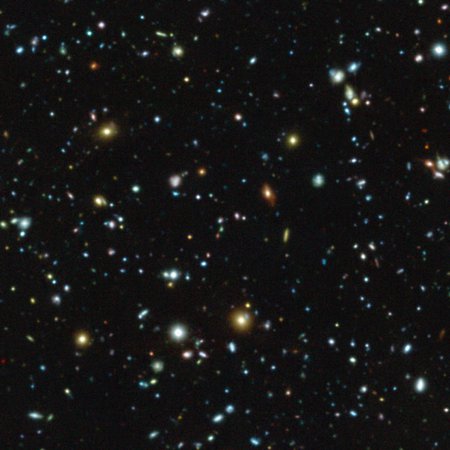Hide and Seek: a Black Hole in a Giant Star Cluster

The centre of the globular cluster NGC 3201, as seen with the MUSE-instrument at the ESO-VLT. The arrow marks the star with the high velocity, which indicates the presence of a Black Hole.
Credit: Sebastian Kamann and the MUSE collaborationAstronomers, under the lead of the Georg-August-Universität Göttingen and with participation of the Leibniz-Institut für Astrophysik Potsdam (AIP) using ESO’s MUSE instrument on the Very Large Telescope in Chile have discovered a star in the cluster NGC 3201 that is behaving very strangely. It appears to be orbiting an invisible black hole with about four times the mass of the Sun — the first such inactive stellar-mass black hole found in a globular cluster and the first found by directly detecting its gravitational pull. This important discovery impacts on our understanding of the formation of these star clusters, black holes, and the origins of gravitational wave events.
Globular star clusters are huge spheres of tens of thousands of stars that orbit most galaxies. They are among the oldest known stellar systems in the Universe and date back to near the beginning of galaxy growth and evolution. More than 150 are currently known to belong to the Milky Way.
One particular cluster, called NGC 3201 and situated in the southern constellation of Vela (The Sails), has now been studied using the MUSE instrument on ESO’s Very Large Telescope in Chile. An international team of astronomers, led by the University Göttingen and with researchers from AIP, has found that one of the stars in NGC 3201 is being flung backwards and forwards at speeds of several hundred thousand kilometres per hour, with the pattern repeating every 167 days.
Lead author Benjamin Giesers (Georg-August-Universität Göttingen, Germany) was intrigued by the star’s behaviour: “It was orbiting something that was completely invisible, which had a mass more than four times the Sun — this could only be a black hole! The first one found in a globular cluster by directly observing its gravitational pull.”
The relationship between black holes and globular clusters is an important but mysterious one. Because of their large masses and great ages, these clusters are thought to have produced a large number of stellar-mass black holes — created as massive stars within them exploded and collapsed over the long lifetime of the cluster.
ESO’s MUSE instrument (developed and built by Göttingen and Potsdam, amongst others) provides astronomers with a unique ability to measure the motions of thousands of far away stars at the same time. With this new finding, the team has for the first time been able to detect an inactive black hole at the heart of a globular cluster — one that is not currently swallowing matter and is not surrounded by a glowing disc of gas. They could estimate the black hole’s mass through the movements of a star caught up in its enormous gravitational pull.
From its observed properties the star was determined to be about 0.8 times the mass of our Sun, and the mass of its mysterious counterpart was calculated at around 4.36 times the Sun’s mass — almost certainly a black hole.
Peter Weilbacher, one of the co-authors from AIP and in charge of the data reduction software for MUSE, is delighted: “A few years ago, the development of the detection methods started with a predecessor instument (PMAS) in Potsdam. With this discovery, the project has yielded a spectacular result.”
There is also an interesting historical connection to this discovery. “In 1915, Karl Schwarzschild was the first person to find a solution of the field equations of Einstein – at the time just a theoretical construct for what we call a black hole today. Also, Schwarzschild was head of the Göttingen observatory, before he became director at the Astrophysical Observatory Potsdam”, Martin Roth explains the historical connections between the German partner institutes.
The development of MUSE and the research about the globular clusters at Potsdam and Göttingen is supported by the BMBF Verbundforschung.
Further information
Scientific article
ESO webpage for MUSE instrument at VLT
AIP webpage for MUSE
Development of the MUSE integral field spectrograph
Press release, images and movies at ESO
Images
The centre of the globular cluster NGC 3201, as seen with the MUSE-instrument at the ESO-VLT. The arrow marks the star with the high velocity, which indicates the presence of a Black Hole.



